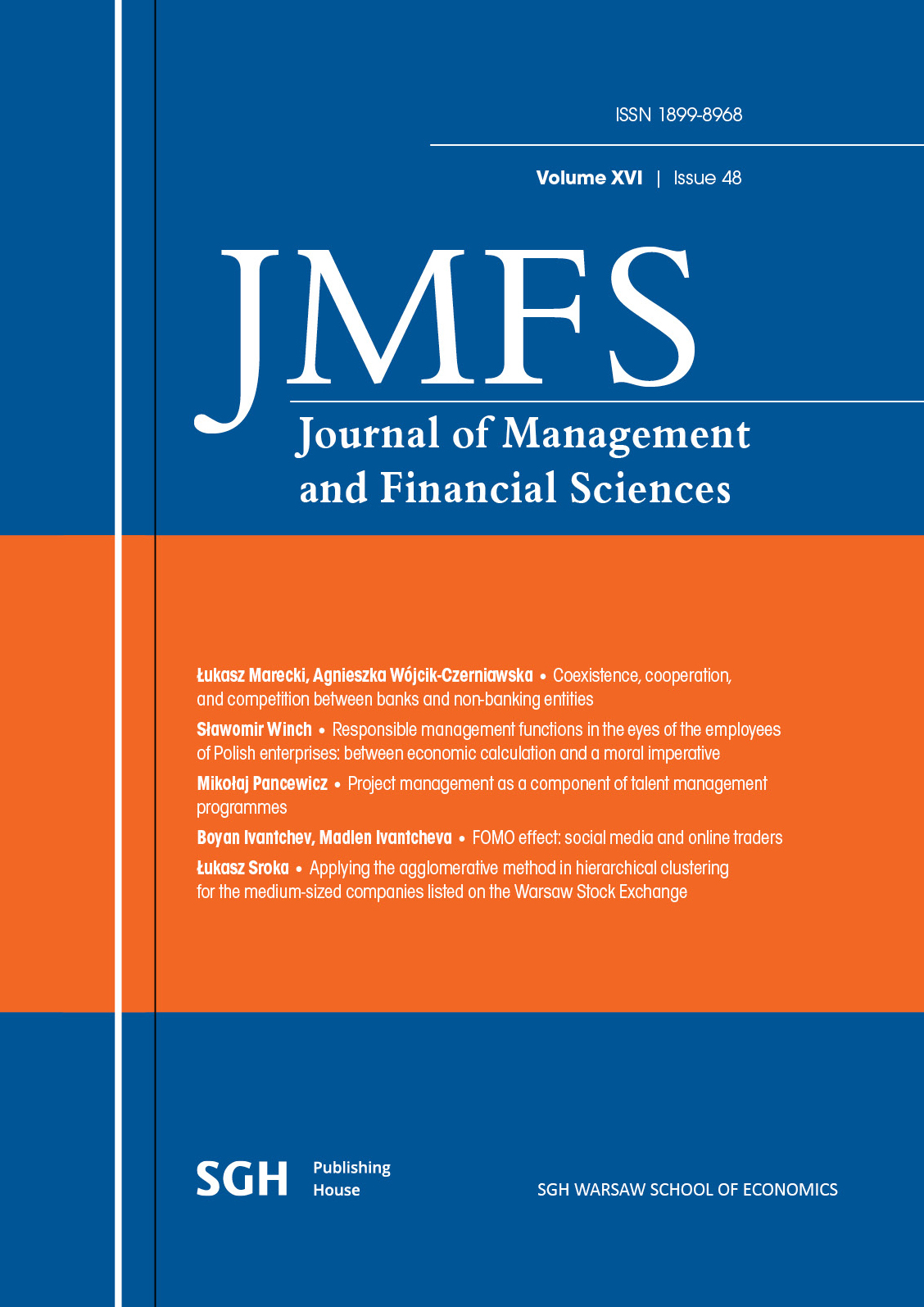Applying the agglomerative method in hierarchical clustering for the medium-sized companies listed on the Warsaw Stock Exchange
Main Article Content
Abstrakt
The purpose of this article is to use a hierarchical algorithm to reduce the number of companies in stock exchange portfolios, together with the identification of the most and least profitable groups of the companies. To prepare the research, the author decided to use a hierarchical clustering method to segment mWIG40 index entities. The conducted research contributed to the knowledge of the segments appearing on mWIG40 index and the profitability of the obtained clusters in the analyzed period. It was concluded that the hierarchical clustering method can divide the entities from mWIG40 index into six segments. The obtained groups differed from each other in terms of the analyzed features. Moreover, it was found that it was possible to identify more and less profitable segments in terms of the rate of return. What is more, only one segment was characterized by a higher rate of return than the benchmark. The findings can help investors to make better decisions during their investing process. In addition, the results can help companies to map their business in the market.
Downloads
Article Details

Utwór dostępny jest na licencji Creative Commons Uznanie autorstwa 4.0 Międzynarodowe.
Bibliografia
Alford, W. A. (1992). The effect of the set of comparable firms on the accuracy of price earnings valuation method. Journal of Accounting Research, 30 (1), pp. 94–108.
Bai, H., Xing, Z. F., Cambria, E., Huang, W. (2019). Business Taxonomy Construction Using Concept-Level Hierarchical Clustering. arXiv preprint arXiv:1906.09694.
Bholowalia, P., Kumar, A. (2014). EBK-Means: A Clustering Technique based on Elbow Method and K-Means in WSN. International Journal of Computer Applications, 105 (9), pp. 17–24.
Bin, S. (2020). K-Means Stock Clustering Analysis Based on Historical Price Movements and Financial Ratios Scholarship. Retrieved from: claremont://scholarship.claremont.edu/cmc_theses/2435/ [accessed: 1.12.2021].
Boschetti, A., Massaron, L. (2016). Python Data Science Essentials. 2nd Edition. Gliwice: Helion.
Craighead, S., Klemesrud, B. (2002). Stock Selection Based on Cluster and Outlier Analysis, Fifteenth International Symposium on Mathematical Theory of Networks and Systems, University of Notre Dame, pp. 12–16.
Davison, I., Ravi, S. S. (2005) Agglomerative Hierarchical Clustering with Constraints: Theoretical and Empirical Results, Proc. 15th European Conference on Principles and Practice of Knowledge Discovery in Databases (PKDD 2005), Porto, Portugal, pp. 59–70.
Day, W. H., Edelsbrunner, H. (1984). Efficient Algorithms for Agglomerative Hierarchical Clustering Methods. Journal of Classification, Vol. 1, pp.1–24.
Dokmanic, I., Parhizkar, R., Ranieri, J., Vetterli, M. (2015). Euclidean distance matrices: essential theory, algorithms, and applications. IEEE Signal Processing Magazine, 32 (6), pp. 12–30.
Esmalifalak, H., Ajirlou, A. I., Behrouz, S. P., Esmalifalak, M. (2015). (Dis) integration levels across global stock markets: A multidimensional scaling and cluster analysis. Expert Systems with Applications, 42 (22), pp. 8393–8402.
Everitt, B. (1980). Cluster analysis. Quality & Quantity: International Journal of Methodology, 14 (1), pp. 75–100.
Ferreira, L., Hitchcock, D. B. (2009). A Comparison of Hierarchical Methods for Clustering Functional Data. Communications in Statistics – Simulation and Computation, 38 (9), pp. 1925–1949.
Hair, J., Anderson, R., Tatham, R. Black, W. (1998). Multivariate data analysis. 5th Edition, New Jersey: Prentice Hall.
Kądziołka, K. (2018). Zastosowanie metod grupowania hierarchicznego w strategiach portfelowych. Zeszyty Naukowe Zachodniopomorskiej Szkoły Biznesu Firma i Rynek, 1 (53), pp. 115–124.
Kopczewska, K., Kopczewski, T., Wójcik, P. (2009). Metody ilościowe w R, Aplikacje ekonomiczne i finansowe. 2nd Edition. Warszawa: CeDeWu.
Korzeniewski, J. (2017). Zastosowanie analizy skupień do konstrukcji portfela akcji na GPW. Prace Naukowe Uniwersytetu Ekonomicznego we Wrocławiu, 468, pp. 108–115.
Kubiczek, J., Hadasik, B. (2020). Segmentation of the electric scooter market in Poland. Econometrics. Ekonometria. Advances in Applied Data Analytics, 24 (4), pp.50–65.
Kuiper, F. K., Fisher, L. (1975). A Monte Carlo comparison of six clustering procedures. Biometrics, 31, pp. 777–783.
Lahmiri, S. (2016). Clustering of Casablanca stock market based on hurts exponent estimates. Physica A: Statistical Mechanics and its Applications, 456, pp. 310–318.
Leon, D., Araggn, A., Sandoval, J., Hernnnde, G. (2017). Clustering Algorithms for Risk – Adjusted Portfolio Construction. Procedia Computer Science, 108, pp. 1334–1343.
Majerova, I., Nevima, J. (2017). The measurement of human development using the Ward method of cluster analysis. The Journal of international studies, 10 (2), pp. 239–257.
Marinova-Boncheva, V. (2008). Using the Agglomerative Method of Hierarchical Clustering as a Data Mining Tool in Capital Market. International Journal Information Theories & Applications, 15, pp.382–386.
Nitin, G., Patel, R., Bruce, P. C. (2007). Data Mining for Business Intelligence: Concepts, Techniques, and Applications in Microsoft Office Excel with XLMiner. 2nd Edition. New Jersey: John Wiley & Sons.
Pośpiech. E. (2016). Comparative analysis of selected clustering methods of listed companies. Zeszysty Naukowe Uniwersytetu Ekonomicznego w Katowicach, 297, pp. 153–165.
Raschka, S., Mirjalili, V. (2017). Python mashine learning. 2nd Edition. Gliwice: Helion. Roman, W. (2016). Zastosowanie hierarchicznej metody aglomeracyjnej do grupowania państw OECD ze względu na efektywność wykorzystania energii. Roczniki Kolegium Analiz Ekonomicznych, 40, pp. 411–424.
Stanisz, A. (2007). Przystępny kurs statystyki z zastosowaniem STATISTICA PL na przykładach z medycyny. Tom 3. Analizy wielowymiarowe. Kraków: Statsoft.
Szekely, G. J., Rizzo, M. L. (2005). Hierarchical Clustering via Joint Between-Within Distances: Extending Ward’s Minimum Variance Method. Journal of Classification, 22, pp. 151–183.
Walesiak, M. (2011). Uogólniona miara odległości GDM w statystycznej analizie wielowymiarowej z wykorzystaniem programu R. Wrocław: Wydawnictwo Uniwersytetu Ekonomicznego we Wrocławiu.
Ward, J. H. (1963). Hierarchical Grouping to Optimize an Objective Function. Journal of the American Statistical Association, 58 (301), pp. 236–244.
Zuhroh, I., Rofik, M., Echchabi, A. (2021). Banking stock price movement and Macroeconomic indicators: k-means clustering approach. Cogent Business and Manaement, 8 (1).
